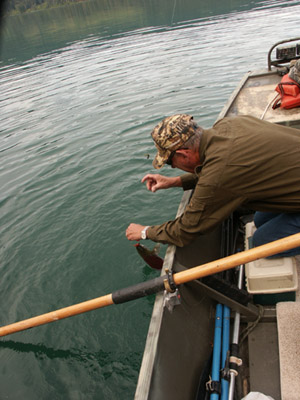
In my earlier articles on Mastering the Basics, I drew from my own experience honed over many years of learning and practicing the skills associated with fly angling. In writing Mastering the Basics of Stillwater Fly Fishing, I do not profess to be an expert or authority on stillwater fishing. In my five decades of fly fishing and my years of guiding, I concentrated mostly on moving waters, with the exception of high-elevation lakes. At age 62 I do not have the luxury of slowly acquiring stillwater skills over a period of years. Now that I live across the street from Klamath Lake / Agency Lake, which harbors huge trout, I am dedicated to honing my stillwater fishing skills. Over the past few years I have hooked and landed a number of trout from Agency Lake in the four to seven pound range, but I also grudgingly admit that I have been skunked more times than I care to share.
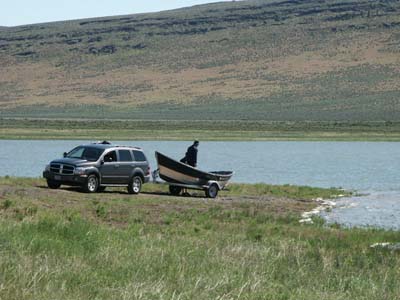
I have included a glossary and a test, to this section on Mastering the Basics of Stillwater Fly Fishing. The test was a useful tool for me, but I hope it will be fun for those of you new to the sport. As a retired teacher, I know the value of reading, outlining information and then writing a test in order to really learn the material. However, the ultimate and final test is on the water, and I hope that this information will help you accelerate your skills as it has for me.
I have struggled with how I am to present the information in Mastering the Basics of Stillwater Fly Fishing. Since I know I will rework this material in the future, and return to it many times to add photographs and illustrations, I have decided to organize the information with bold headings and bulleted markings to aid in quick reading. Sometimes I will merely outline the material if I do not see the need for expansive explanation.
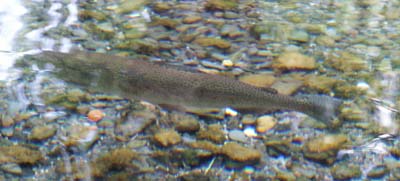
If you are new to stillwater fishing, I recommend that you take the test first and then peruse through the glossary that I have provided. I also recommend that you take along a small notepad with specific goals or experimenting techniques that you will practice when you get out on a lake nearest you. Be sure to take notes on what you learned! In this manner you will experience an accelerated learning curve for Mastering the Basics of Stillwater Fly Fishing. Finally, if you live far from a trout lake, then fly fish for bass and sunfish in a lake close to you. The principles are very similar.
What You Need to Know About Stillwater and Stillwater Trout
If you are an experienced bass angler, you clearly have a head start in pursuing and catching trout in stillwater. Here is a basic review of all that I have learned bass fishing that is directly applicable to stillwater trout fishing.
Lake Anatomy: The size, depth, shoreline, bottom composition, elevation, annual precipitation and the ph balance (0-17) are defining factors in trout survival and growth.
Size and Type: Find the nearest trout lake and seek out information on good fishing areas. Become an expert on one area before you concentrate your efforts five miles down the lake. Begin with locating a section of the lake that has an inlet or an outlet or feeder streams dumping into the lake. These are good holding areas for trout, as they supply cooler, oxygenated waters and good food sources. Reservoirs, because of the water draw downs during the late spring and summer, make life tougher for trout than bass. Insects, their primary food source, are impacted greatly and in some cases nearly eradicated due to the extreme draw downs. Seepage Lakes, especially low elevation lakes, have no inlets or outlets. They sustain fertile water conditions from mountain seepage and groundwater seepage. Denny Rickard reminds readers in his book that the key to a good trout lake is the percentage of shallow shoreline, which provides food and cover for trout. Sunlight is another determinant to sustained growth of trout. More sunlight means longer plant growth seasons, more insect life, and thus more food sources for longer periods. PH Levels measure the level of acid or alkalinity in a particular body of water. A pH balance of 5 to 7 is ideal for sustained trout growth according to Rickards.
Targeted Waters / Cover: Read any good bass fishing book and you will learn most of what there is to know about stillwater fishing for trout. Keep in mind the obvious. Trout need cover to protect themselves from overhead predators. They need overhead obstructions or camouflaging to break up their outline. They need cooler waters that provide sufficient oxygen, and they need to be close to good sources of food. So in alphabetical order, here are some “fishy” spots to target: algae blooms, bays, branches, channels, cliffs, downed trees, drop-offs, feeder streams, inlets and outlets, points, rocks, river channels, shoals (submerged islands), springs, vegetation.
(P#4:cover)
Water Zones: When sunlight can not reach the bottom, which in turn stimulates plant growth and thus oxygen, the zone is referred to as the Chemocline or Profundal zone. The Thermocline is a narrow zone of water lower in oxygen than the surface. It tends to hover just above the Chemocline as the surface waters heat up during the summer months. Trout will often seek refuge near the thermocline. Keep in mind, however, that the ideal spot for any fish is one which provides cool, oxygenated waters close to the shallows, which provides their food source. Lake Turn-Over: Water is heaviest at 39 degrees. At this temperature it drops to the bottom so during the winter when the surface temperature is 32 degrees the bottom is warmer. The same is true during the summer when warmer water rises to the top resting on the colder water underneath. Turn over during the spring occurs when the wind creates currents that pull and fold water at the surface, which in turn draws up water from the bottom in a mixing pattern. In the process, bottom nutrients are brought to the surface which aids insects and pulls trout up to warmer waters, typically in the shallows. It also brings more oxygen to the deeper water so fish can be found at all levels during the spring turn over. The division of these two water layers in called the Thermocline. During a lake turn over the thermocline disappears. Below the thermocline in larger lakes is the Chemocline, which is deeper water holding insufficient levels of oxygen. During the fall the turn-over begins anew as winter approaches.
Windows of Opportunity: Look for birds, such as
swallows and night hawks, actively swarming over the water, which
indicates a hatch in that area. Of course, one should look for rises,
but keep in mind that some surface takes are quite subtle and go
unnoticed. On wind rippled water, Rickards says to look for “nervous”
water. Look for water that moves contrary to the natural water movement
around a particular spot that has drawn your attention. Use a monocular
or binoculars to help you scan waters in the near vicinity for a sparse
hatch. Remember, it doesn’t take much activity to get the attention of
trout that there is food on the surface. And speaking of food, the
experts are unanimous in declaring that 90% of stillwater fishing
should be under the surface!
Overcast or dark days or rippled
water provide opportunities for trout to move into the shallows and
feed. On windy days, the shoreline is a natural area to target because
the waves churn up food sources and trout will often move right into
this frothy, muddy water. Look for points or small islands during
spells of wind. Fish down from the point or just inside an island, as
the island or point will provide a sheltered area of water which blown
insects can readily be spotted by lurking trout. It is the same for
stream fishing. Ice-Out provides excellent fishing as trout are hungry.
As the water begins to warm somewhat after ice-out, be sure to target
inlets which are staging areas for pre-spawning, hungry trout. During
the spring be sure to try a Glo-Bug at the inlets and outlets. As all
bass fishermen know, an approaching storm tends to stimulate a bite.
Times to Avoid: Avoid fishing during a period of the full moon. Watch out for lightening, and stay home during a cold front with a falling barometer.
Recommended Equipment:
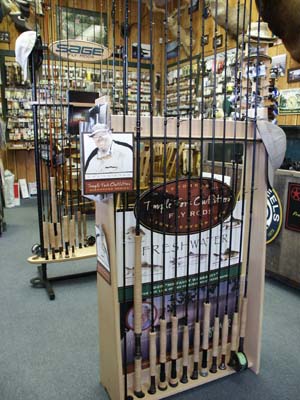
Rods: Clearly, a slow-action rod is most endorsed by the experts. The slower action rods absorb the shock of a large fish on the take. Light tippets do not hold up on a stiffer rod when a large trout fights in underwater vegetation. Many of the experts, both guides and authors that I have met, use 5 wt rods from 8.5 to 9.5 in length. As always, it is a personal preference. Certainly 5 – 8 weight rods will all do fine.
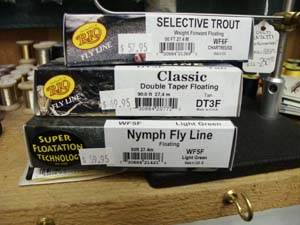
Floating Lines: The most versatile line is the weight-forward or double-tapered floating line. Weight can be added to the fly or the leader to effectively fish depths of 20 feet with a 25-foot leader, split shot and strike indicator.
Sink Tips: A 10 sinking tip at the terminal end of a floating line, these lines are nice to have for depths up to ten feet, but in my opinion, someone on a limited budget should buy an Intermediate Sinking Line before they begin the expensive acquisition of shooting heads or sink tips. Sink tips do have an advantage in that they are easier to pick up and cast again, especially in and around vegetation and floating mats.
Intermediate Full Sinking Line: The one clear advantage of this line is that its rate of descent is slower, which allows longer retrieves at a designated depth. Unlike fast sinking lines and sink tips, it does not impart a hinge. Rather, it sinks informally its full length. This line is best utilized along shoreline cover down to eight feet. Years ago I was fishing Nevada’s Pyramid Lake using a lead-core shooting head. Although I was using a similar fly to the fellow perched on a ladder next to me, he was out fishing me 2-1. When the school of fish would come down the shore line, he could keep his nymph in the target zone twice as long as I could with my heavy shooting head. I switched to a sinking tip and improved my catch rate. Now I carry a floating line, a sink-tip and an intermediate full sinking line. (I also have a Quad Tip, but I can’t decide if I like the system. The loops are just too big.)
Uniform Full Sinking Lines: These lines are designed to reach the bottom, or a specific depth, quickly, especially waters from 10 to 20 feet in depth.
Line Color: It is generally accepted that lighter
colored lines or the new transparent lines create less shadows and
minimize spooking fish.
Casting Distance: A 50 to 80 foot cast is most desirable on calm water;
a longer cast allows you to get in a good retrieving rhythm and it
targets more fish.
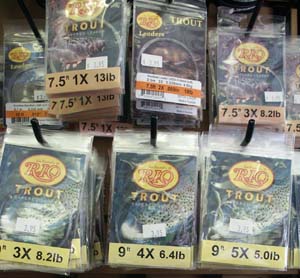
Leaders: A ninth foot 4X or 5X leader is a minimum.
Leaders from 12 to 15 feet are more effective. When you use a strike
indicator in deeper water with a floating line, than 15 to 20 foot
leaders are not uncommon, but they are challenging to cast. Croft
reminds his readers, if they plan on dry fly fishing on the surface, to
keep grease or floatant free of the last six inches so that the tippet
sinks under the water next to the fly.
Thermometer: Use a thermometer to check the conditions. Water
temperatures from 70 and above push trout to cooler water. The comfort
zone for trout ranges from 60-68.
(P#8:tippet)
Tippet: The terminal end of a leader is the tippet. Tippets are rated by diameter and strength. Manufacturers still follow the diameter size with a designated X rating from 0X to 8X. 4X, the mid range at .007 diameter, is probably the most popular diameter. Like Croft I have always added a 4X extension to my 4X leaders using good quality tippet material. Always check the tippet on a new leader as they are prone to breakage from nicks and weak spots. If you need to size down to a 5X or 6X, it only takes a minute.
Searching Patterns: In the absence of rising fish, or fish located cruising though the area, a searching pattern is the “Go-To” choice. Determine the most prolific food sources for a particular body of water. Of these, which food sources are most abundant throughout a season or time period? The experts recommend beginning with the ubiquitous Chironomid midge, followed by scuds and dragonfly nymphs and damsel nymphs. Finally, a leech pattern is a good “Go-To” searching pattern anytime of the year. Be sure to cast in all directions around your anchored boat. In his book, Fly-Fishing Stillwaters for Trophy Trout, Denny Rickards recommends narrowing your fly selection to generic or representative patterns that can simulate more than one food source. He points out that trout “feed opportunistically on suggestive patterns [more so] than exact imitations.” He has developed a number of these suggestive patterns such as Denny’s Seal Bugger, Denny’s Stillwater Nymph and his All Purpose (AP) Emerger.
(P#9: searching patterns)
Chironomids or Midges, although resembling mosquitoes,
do not bite. Ranging from the miniscule in size to an inch in length,
they tend to reflect the water conditions in which they live in terms
of shading or body color hues. Recommended hook sizes range from 12 to
#20 using 5X or 6X tippet. Use an aquarium net or a stomach pump to
match the abdomen of a midge hatch in selecting an appropriate color.
Colors typically range from tan through the green and brown tones and
even dark green or black. Most of the experts favor green hues.
Stillwater anglers rely heavily on Chironomidae patterns as these
midges, as they are often called, hatch year-around. Rowley states in
his book, Fly Patterns for Stillwaters, that Chironomids make up “40%
of the trout’ diet during the open water season. Chironomids are the
first and most prolonged hatch of the fishing season.” (p.11) They also
range in the shallow depths of a lake to the profundal zone. Midge
larva species that crawl around in the mud in low oxygenated waters
typically are bright red from the hemoglobin in their system. These
larvae are referred to as Blood Worms.
(P#10:Blood Worm)
Because many Chironomids live in deeper waters, their migration to
shore as pupae is important to the trout as well as anglers. As larva
they are usually too deep and too slow moving to attract much attention
from trout. They are slow, tentative swimmers in their ascent to the
surface, but once they break through the surface film, they emerge and
escape as duns in four or five seconds. Unlike mayflies they do not
have a spinner fall so the pupae stage is the most important stage for
stillwater fly anglers. Even in the middle of a hatch, most experts
recommend fishing a nymph pattern just under the surface with a
floating line. The exception to this rule is to imitate a entrapped
cripple, which offers a more leisurely take for the trout.
Patterns for Chironomid Larvae: San Juan Worm, Frostbite Bloodworm, Super Floss Bloodworm, Yarn Bloodworm.
Best Times: Low light conditions
Retrieval for the Blood Worm: Let the fly settle to the bottom. Use a strike indicator and little or no retrieve.
Retrieval for the Chironomid Pupa: Overwhelmingly, the experts agree that agonizing patience is needed to slowly work a Chironomid pupa vertically to the surface. Use a slow hand-twist retrieve with long pauses after moving the pattern an inch or two!
Patterns for the Chironomid Pupae: Bronzie, Chromie, Pearl Pupa, Thompson’s TDC, Gold Ribbed Hare’s Ear, Zug Bug.
(P#11:Chironomid Patterns)
Breaking through the surface film, which is not always easy on calm
days, the pupa struggles to escape from its pupa shuck. Many of the
pupae become entangled and trapped while struggling to escape their
shuck, dry their wings and fly away. Any delay or struggle attracts the
attention of feeding trout that pick them off as they linger in the
surface. Once the pupa splits the thorax of the shuck, it dries off its
wings and flies away in seconds. To successfully fish the emerger, the
fly must rest in the surface film. Rowley touts his Para Pupa. Croft
recommends a Compara Dun. Most of the experts, however, recommend
staying with a pupa pattern fished just below the surface right through
the hatch. One advantage of using a strike indicator, when fishing
close to the shoreline, is that the wind, rippled waters lift and bob
the suspended midge pattern, which imparts a realistic motion to the
fly.
Patterns for the Chironomid Cripple or Emerger: Griffith’s Gnat (cripple), Compara Dun, Para Pupa, Raccoon.
(P#12: Cripples)
Scuds
Scuds are the second “Go-To” pattern and
a predominant food source in most lakes and an important source of
protein for wild trout. Ranging is size from ¼” to almost an inch in
some lakes, the scud looks like a freshwater shrimp, but in fact it is
a crustacean. Scuds find safe haven close to shore around weed beds,
and their coloration reflects their surroundings. They mostly avoid
direct sunlight. All the experts agree that since they swim straight,
patterns should be straight. They swim slowly and erratically, but they
are capable of quick bursts of speed so a variety of retrieves are
worth trying. Turn over rocks and shake submerged weeds to ascertain
size and color. Pregnant females have an orange or pinkish brood sac,
but all pink indicates a dead scud! Typically scuds are pale yellow to
green. However, their backs are darker than their underside. Preferred
sizes range from size 10 to size 16, and most patterns are lightly
weighted.
Scud Patterns: Gold-Ribbed Hare’s Ear, Zug Bug, Sparkle Shrimp, Pearl Shrimp.
(P#13: Scuds)
Damselflies: The duns, which are not much of a food item for trout, are most noted for their blue and black color and two sets of wings. The nymph, on the other hand, is an important food source year around. Measuring one to two inches in length, they blend into their surroundings, although they typically are shades of brown and green. Preying on other insects, they swim with a wiggling motion, but like the scud they may have a burst of speed followed by a pause. Late spring and early summer they migrate to the shore where they climb weed stalks and any other protruding objects to leave the water and spend the rest of the time as flying insects. Since the nymphs are migrating to shore, Croft suggests casting from the shore and retrieving back to the shore.
(P#14: Damselfly)
Damselfly Retrieve: Using a faster retrieve than a Chironomid nymph, use a hand-twist retrieve followed by a short burst and then a pause. Add a twitch and a pause for each retrieve.
Damselfly Patterns: (Size 10 hook size on 2X or 3X hook) Denny’s Stillwater Nymph, Gold Bead Damsel, Woolly Buggers, Seal Buggers.
(P#15: Damsel nymph patterns)
Dragonfly: Unlike the Damselfly which has a one year cycle, the Dragonfly has a three or four year cycle so the size of the fly is not as critical. Dragonfly nymphs are “Go-To” patterns, and the most common imitation is the Woolly Bugger. Like Damselflies, Dragonflies are an important food source for trout year around. Target the weedy and woody areas of a lake or pond. A number of the experts suggested trolling a Dragonfly Nymph just off the shore from a kick boat or belly boat on a full sink line. The color of Dragonfly nymphs ranges from light green to a green-brown mix. A number 4- 8 hook size on a 2X or 3X shank is recommended. The dragonfly’s propulsion system is much like a water jet pump. Pulling in water through their gill chamber, they discharge it out through their rectum, which gives them quick 3 to 5 inch bursts of speed.
(P#Dragonfly)
Dragonfly Patterns: Carey Special, Woolly Bugger.
(See Phillip Rowley’s book, Fly Patterns for Stillwaters, for notable patterns developed by British Columbia stillwater experts.)
Dragonfly Retrieve: Work the Dragonfly near the bottom with a full sink line. Use very short strips with the occasional short bursts followed by a pause. Keep in mind that silt-living dragonflies capture their prey by ambush. They move very slowly across the bottom so a slow hand retrieve along with short pauses should also be utilized.
Leeches: Another important food source for stillwater trout, leeches look like a worm, but they have a flat paddle which helps them propel through the water in an undulating manner similar to fans at a stadium doing a wave. The great majority of leeches are not of the blood sucking variety. Although they reach upwards to four inches in length, the smaller sizes seem to be more enticing. The experts recommend sizes 10-6 long-shank hooks. Target the shoreline. Depending on the water color, leeches typically range in color from olive to reddish-brown to black. The leech is also a good pattern to slowly troll just off the shoreline. It is an especially useful pattern during the summer when hatch activity has slowed. As they are nocturnal creatures inhabiting heavily vegetated areas, the leech pattern is best used during low light conditions. To match the coloration of leeches in a particular body of water, Croft recommends cracking an egg and placing it in the water after dark. With their keen sense of smell, they will locate the egg in no time.
Leech Retrieve: Slow hand retrieves or one-inch pulls followed by a pause is the most recommended leech retrieval rate. Rowley recommends adding weight up front on the hook so as to achieve a jigging motion after the pause. Rickards alternates between “very quick one-inch pulls [and] long slow steady strips with deliberate pauses between pulls.” (p. 21)
Leech Patterns: Seal Bugger, Woolly Buggers, Marabou Leech, Mohair Blood Leech.
(P#17:Mayfly)
Callibaetis Mayfly: Although abundant in streams, mayflies do not profusely inhabit stillwaters as they do in rivers and streams. One of the exceptions, however, is the Callibaetis, the speckled-wing mayfly. Preferring clear water, lakes with Callibaetis mayflies are an important trout food source as nymphs, duns and spinners. Typically, two or three hatching periods occur throughout the season with each successive hatch smaller in size from the last (12 down to #16). During spring the hatch comes off mid-morning, but as the season progresses, hatches occur in the early morning and low light of evening. Mottled in browns and tans with speckled, translucent wings, the Callibaetis mayfly can be found across the country, including famous trout rivers offering slower water. Croft recommends noting the time of day of a Callibaetis hatch on a particular body of water and then arriving at the same spot an hour earlier the next day to fish with a nymph pattern.
The Callibaetis Mayfly is a swimmer, as opposed to crawlers, clingers and burrowers. As nymphs they are active swimmers in and around vegetation, and they are surface emergers. Slender and elongated, the Callibaetis nymph runs the usual gamut of colors from tan to gray and from olive to brown with darker backs. On their ascent to the surface, they too use trapped air and gas, which imparts a silvery sheen to their body. With the distinct silhouette of a sailboat, the dun can also range in color based on the water coloration. One distinguishing pattern, however, is their mottled and translucent wings and two long tails.
Nymph Patterns: Gold-Ribbed Hare’s Ear, Pheasant Tail Nymph.
Callibaetis Dun / Emergers / Cripples: Much like spring creek conditions, trout have the opportunity to inspect and recognize a fake when they see one. Bring along a small dipping net and inspect and compare the dun with your simulated pattern. Sometimes it is easier to entice a strike with a cripple pattern than a dun pattern. Popular dun patterns include Parachute Adams, Adams and a Compara-dun. If you are fishing a good hatch and you have exhausted your best patterns without success and experience a rising mood of panic or frustration, fish an emerging nymph pattern on a dry line just under the surface.
(P#18: Minnow Patterns)
Minnows: Although I have had much success with streamer patterns in rivers and on lakes targeting bass, I have had limited success with minnow streamers in lakes. However, I duly acknowledge that others rate Zonkers and Woolhead Sculpins, especially in the early spring and fall, as their “Go-To-Pattern.” Oddly enough, last year I caught a 7-pound Klamath Lake rainbow with a fly rod and a 1-inch Rapala minnow as my “fly”. At my age I don’t care about being unorthodox!
(P#19: Crawdad Pattern)
Don’t overlook crawdad patterns and fishing with beetles, ants and hoppers during the summer. I hope the glossary helped and that you had fun taking the Stillwater Fishing Test. Be sure to read my annotated bibliography and the books that I recommend below. Finally, I rarely get any feedback, constructive or otherwise. Drop me an email at: dave@glaciertoyellowstone.com. Good fishing!
Dave Archer
Bibliography
Most of the material in this article is from the following books. I have placed them not in alphabetical order, but in my personal order of preference. I have looked for consensus and shared common information. Whenever I use information specific to one author, I have cited the author’s name rather than using end notes.
1. Fly-Fishing Stillwaters for Trophy Trout by Denny Rickards (ISBN: 0-9656458-0-0) A Stillwater Productions Publication, PO Box 470, Fort Klamath, OR 97626
Rickards’ book is 181 glossy pages of beautiful photographs and
illustrations and a clear treatise on stillwater fly fishing for trophy
trout. He is both methodical and thorough. Sharing years of original
research, Rickards holds nothing back. He wants every reader who
applies his principles to achieve success. It is a beautiful and
absorbing book.
2. The Fish Bum’s Guide to Catching Larger Trout, an illustrated manual on stillwater tactics for the intermediate fly angler, written and illustrated by Mike Croft
(ISBN: 1-57188-142-5) Frank Amato Publications. In the spirit and
tradition of The Curtis Creek Fly Fishing Manifesto, I couldn’t resist
buying this book. After reading a half dozen books on stillwater fly
fishing, I knew I had to place this book as my second choice. It is
packed with information and quite possibly just as comprehensive as the
rest. For a young angler new to stillwater fly fishing, I would
recommend this book as a primer. It is excellent to review and peruse
because it is illustrated, and the verbiage has been whittled down.
3. Fly Patterns for Stillwaters, A Study of Trout, Entomoly and Tying, by Phillip Rowley (ISBN: 1-57188-195-6) Frank Amato Publications. Rowley is an expert in the field of fly fishing, and he has written many books and feature articles. I bought this book for the tying directions, but what I found was that the book covers almost all the important aspects of stillwater fly fishing from presentation and retrieves to seasons, and the interesting life cycle of all the insects he imitates.
4. Morris & Chan on Fly Fishing Trout Lakes, by Skip Morris and Brian Chan
(ISBN: 1-57188-181-6) Frank Amato Publications. Morris and Chan have
produced an exceptionally written, photographed and illustrated book
for the beginning or intermediate stillwater fly angler. It is
certainly a tie for my second choice. It ended up in the number four
spot only because I felt I had to place Rowley’s fly pattern book up
close to the top.
5. Strategies for Stillwater, by Dave Hughes (0-8117-1916-2) Stackpole Books. I read every word in Hughes’ book and can recommend it as a definitive book on stillwater fly fishing. I do not enjoy reading instructional books on any subject when they are bereft of bold headings, boxed information, lots of photographs and illustrations and a format that aids in reviewing the information. Nonetheless, Strategies for Stillwater is as comprehensive as Denny Rickards’ book, and I learned a great deal from reading it.
6. ‘The Gilly’ A flyfisher’s Guide by Contributors (ISBN:0-88925-638-1) Published by Alf Davy. An excellent resource, especially for those anglers heading to British Columbia, it too is organized and presented as mostly text.
7. Fly Fishing the Mountain Lakes by Gary LaFontaine (ISBN: 0-9626663-7-8)
Greycliff Publishing Company. This book is a great read both for
information on fishing high elevation lakes as well as a chronicle of
LaFontaine’s fishing adventures. I loved it, but I also became somewhat
depressed with how much equipment the experts rely on in fishing as an
expert!
To read all my Mastering the Basics series, visit my companion site, Fishing Tips 101.

Leave a comment